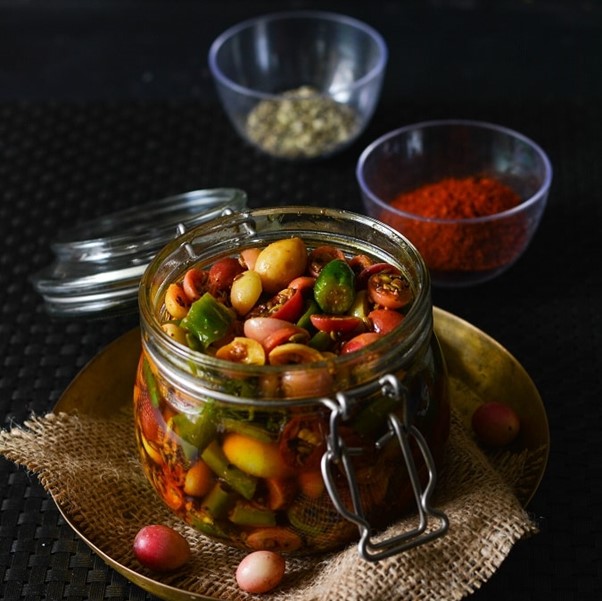One of the most versatile and flavorful pickles in Indian cuisine is the karonda pickle. Made from the small, glossy karonda fruit, also known as Natal Plum or Carissa carandas, this tangy pickle is a beloved part of Indian culinary traditions and can be enjoyed throughout the year.
In this blog, we’ll take a flavorful journey into the world of Karonda pickle, exploring its culinary importance, the art of making it at home, and the intriguing regional variations that make it a unique and cherished delicacy all across India.
Must Read: Puran Poli: A Traditional Maharashtrian Delight
The Karonda Fruit and its Culinary Importance
First things first, let’s get to know the star of our show – the karonda fruit! Karonda, also known as Carissa carandas or cranberry tree, is a small, round berry-like fruit that grows on a thorny shrub native to the Indian subcontinent. Its vibrant green hue with a hint of purple adds colour to any dish.
The taste of karonda can be described as a combination of tartness and sweetness, making it a unique and delightful treat for the taste buds. The texture of the fruit is soft yet slightly crunchy, adding to its overall appeal.
Traditionally, karonda is widely used in Indian households to prepare pickles. Pickling karonda involves preserving the fruits in a mixture of spices and oil, allowing the flavours to meld and intensify over time.
This ancient preservation technique ensures that the pickles stay fresh and tasty for months, even years, making them a beloved accompaniment to various meals.
Karonda Pickle Health Benefits
Besides being a tangy delight, karonda pickles are also nutritious. They are a rich source of Vitamin C, providing a natural boost to the immune system. Additionally, karonda pickles contain essential minerals like calcium and iron, which benefit bone health and overall well-being.
Also, one of the key health benefits of karonda is its potential to aid digestion. The pickle’s sourness can stimulate the production of digestive juices, aiding in better digestion and reducing indigestion problems.
Moreover, dietary fibre in the fruit helps regulate bowel movements and keeps your digestive system healthy.
Must Read: 6 Must-Try Dishes in Kashmir for a Great Culinary Experience
The Art of Making Karonda Pickle at Home
If you’re a pickle enthusiast and want to bring the tangy delight of karonda into your home, here’s what you’ll need:
1. Fresh karonda fruits – 500g
2. Mustard oil – 4 tablespoons
3. Mustard seeds – 1 tablespoon
4. Fennel seeds – 1 tablespoon
5. Fenugreek seeds – 1/2 tablespoon
6. Turmeric powder – 1/2 teaspoon
7. Red chilli powder – 1 tablespoon (adjust to your preferred spice level)
8. Asafoetida (hing) – a pinch
9. Salt – to taste
Step-by-step Guide to the Pickling Process:
1. Preparation: Wash the karonda fruits thoroughly and pat them dry with a clean cloth. Slit each fruit slightly to allow the spices to penetrate better.
2. Sun-drying: Place the karonda fruits under the sun for a few hours to remove excess moisture. This step ensures that the pickle stays fresh and retains its tanginess.
3. Tempering the spices: Heat some mustard oil in a pan. Add mustard, fenugreek, fennel, and a pinch of asafoetida. Allow the spices to crackle and release their aromatic flavours.
4. Adding the magic: Turn off the heat and add turmeric powder and red chilli powder to the oil mixture. Stir well to create a fragrant and flavorful base for the pickle.
5. Mix and marinate: Toss the sun-dried karonda fruits into the spice mix, ensuring they are coated evenly. Add some salt and jaggery (if desired) to balance the flavours.
6. Jar it up: Transfer the karonda and spice mixture into a clean, dry glass jar. Seal it tightly and keep it warm for a few days, allowing the flavours to meld together and create a delicious tangy pickle.
Exploring the Varieties of Karonda Pickle
As we journey through the diverse landscape of India, we discover a multitude of regional variations of the karonda pickle, each with its own twist and charm:
1. North Indian Karonda Pickle: This version often includes a blend of spices like cloves, cinnamon, and black cardamom, infusing the pickle with an enticing aroma.
2. South Indian Karonda Pickle: South Indians love to add curry leaves and a hint of asafoetida to their pickle, elevating the taste to new heights.
3. Gujarati Karonda Pickle: Gujaratis prefer a sweeter version of the pickle, where jaggery plays a prominent role, balancing the tanginess of the karonda.
4. Rajasthani Karonda Pickle: This variant boasts an earthy blend of spices, including cumin and coriander seeds, giving the pickle a rustic touch.
Must Read: Best Indian Cuisine to Try at Home and Abroad
Conclusion
From its eye-catching appearance to its unique taste and texture, karonda fruit offers a sensory experience like no other. The process of pickling karonda at home is simple and allows you to savor the flavors of this delightful fruit all year round.
So, next time you come across these little purple gems at the market, don’t hesitate to bring them home and embark on your own karonda pickle adventure. Whether you prefer it spicy, sweet, or somewhere in between, this tangy treat will surely find a special place in your heart and on your dining table. Happy pickling!
